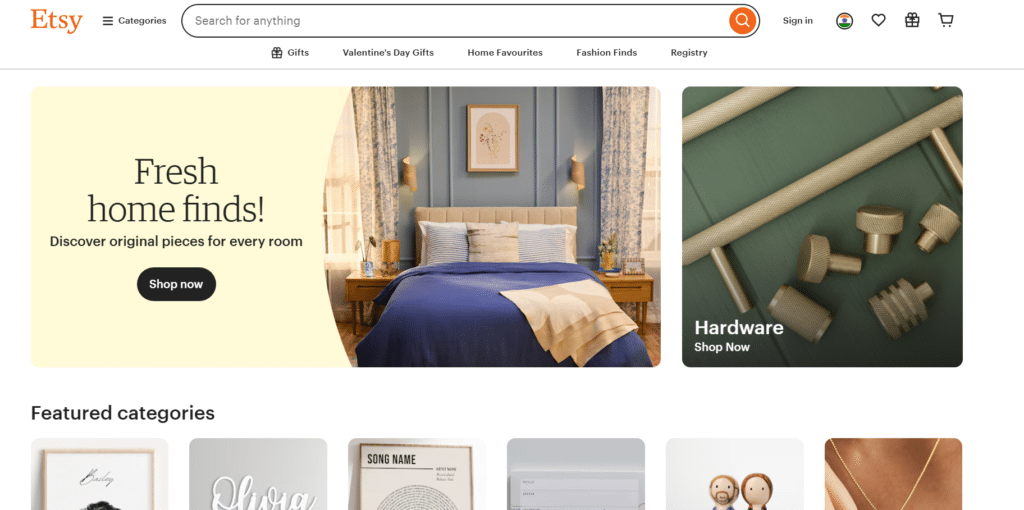Are you considering selling your handmade goods or unique products online? Etsy might be the perfect platform for you.
In this article, we will explore what Etsy is, how selling on Etsy works, the benefits and drawbacks of selling on the platform, and whether selling on Etsy is worth it for you to start your own Etsy shop.
We will also provide tips for success on Etsy to help you maximize your sales and reach a larger audience. If you’re ready to take your creative business to the next level, keep reading!
What is Etsy?

Etsy is an online marketplace known for its unique handmade and vintage items, connecting buyers with independent sellers worldwide.
Emphasizing individual creativity and craftsmanship, Etsy offers a diverse range of products such as jewellery, clothing, home decor, and personalized gifts.
With a strong commitment to supporting small businesses, artisans, and collectors, the platform provides a space for these creators to showcase their talents and reach a global audience.
The seller-buyer interaction on Etsy fosters a sense of community and allows for personal customization, making each purchase a more personalized and meaningful experience for both parties involved.
How Does Selling on Etsy Work?
Selling on Etsy involves creating a seller account, listing products, managing inventory, and handling customer orders through the platform’s tools and resources.
To set up a seller account on Etsy, one must first create a profile by providing essential information such as a shop name, description, and policies. Once the account is established, sellers can start listing their products by uploading images, writing detailed descriptions, and setting prices.
Sellers must maintain accurate inventory records to avoid overselling or running out of stock. Managing orders efficiently involves tracking shipments, communicating with customers, and ensuring timely order fulfilment. Implementing effective SEO strategies is also vital to boost visibility and attract potential buyers.
What Are the Benefits of Selling on Etsy?

Selling on Etsy offers a range of benefits, including access to a large and diverse customer base, tools for marketing and promotion, and low start-up costs, contributing to increased Gross Merchandise Sales (GMS) as reported by Similarweb for Q1 2023.
Large and Diverse Customer Base
Etsy’s appeal lies in its large and diverse customer base, providing sellers with exposure to a wide range of potential buyers interested in unique and handmade products.
This broad customer base on Etsy encompasses individuals from various demographics, including millennials seeking personalized items, eco-conscious consumers in search of sustainable goods, and art enthusiasts appreciating handcrafted pieces.
These buyers are drawn to Etsy for its emphasis on creativity, authenticity, and artisanal craftsmanship, creating a vibrant marketplace for sellers to showcase their products.
Etsy’s platform facilitates connections between sellers and niche markets, enabling sellers to reach specific audiences interested in niche products such as organic skincare, bohemian home decor, or minimalist jewellery.
Easy To Set Up and Manage Shop
Setting up and managing a shop on Etsy is straightforward, with user-friendly tools and resources that streamline the process of listing products, tracking inventory, and engaging with customers.

One key feature that Etsy offers to its sellers is an intuitive user interface that simplifies the process of creating product listings. Sellers can easily upload images, set prices, and write descriptions with just a few clicks.
Furthermore, Etsy provides inventory management tools that help sellers keep track of their stock levels, receive notifications for low inventory, and easily update quantities. This allows sellers to stay organized and prevent overselling.
The platform enables seamless customer interaction through messaging and feedback systems. Sellers can engage with buyers promptly, answer queries, address concerns, and build relationships that foster trust and loyalty.
Etsy also offers analytics tools that provide insights into customer behaviour, popular products, and sales trends. These tools empower sellers to make informed decisions and optimize their shop’s performance.
Low Start-up Costs
Selling on Etsy requires minimal start-up costs, making it an attractive option for new sellers looking to enter the e-commerce market without significant financial investment.
Along with the low start-up costs, one of the key advantages of starting a business on Etsy is the affordability of setting up a shop. Unlike traditional brick-and-mortar stores that come with high overhead expenses such as rent and utilities, Etsy allows sellers to create a virtual storefront at a fraction of the cost. Sellers can list their products for as little as $0.20 per item, enabling them to showcase their unique creations to a global audience without breaking the bank.
Access to Marketing and Promotional Tools
Etsy provides sellers with access to a variety of marketing and promotional tools to enhance product visibility, attract customers, and increase sales through optimized SEO strategies.
One of the most crucial resources that Etsy offers for sellers is SEO optimization tools, which help improve the search engine visibility of their products. By strategically incorporating relevant keywords, sellers can ensure that their listings are more likely to appear when potential customers are searching for similar items.
Along with SEO tools, Etsy also provides robust social media integration features, allowing sellers to easily share their products on platforms like Facebook, Instagram, and Pinterest. This seamless integration can significantly expand the reach of sellers’ products and attract new customers.
Etsy offers various advertising options for sellers to boost product exposure, such as promoted listings and Google Shopping ads. These advertising solutions help sellers target specific audiences and drive traffic to their listings, ultimately leading to increased sales and revenue.
Supportive Community of Sellers
Etsy fosters a supportive community of sellers, offering networking opportunities, shared insights, and collaboration avenues that contribute to a sense of belonging and growth within the platform.

Through interactions with other creative minds, sellers on Etsy can exchange tips, troubleshoot challenges, and gain fresh perspectives on their craft. The platform’s forums and groups provide valuable spaces for connecting with like-minded individuals, fostering relationships that often extend beyond mere transactions.
By tapping into the collective knowledge and experiences of the community, sellers can refine their strategies, stay updated on market trends, and find inspiration for future projects.
What Are the Drawbacks of Selling on Etsy?
Despite its advantages, selling on Etsy comes with drawbacks such as high competition, transaction and listing fees, limited customization options, and dependence on Etsy’s platform for sales.
Competitive pressures on Etsy often require sellers to carefully strategize their product offerings and pricing to stand out in a saturated market.
The financial implications can be significant, as fees can eat into profits, especially for smaller businesses. Customization restrictions may limit a seller’s ability to express their brand or fully cater to specific customer needs.
Being reliant on Etsy’s platform means that any changes or disruptions to the site can directly impact a seller’s ability to reach their audience and make sales. It also diminishes control over one’s business operations, adding a layer of vulnerability to external factors beyond the seller’s control.
High Competition
Etsy’s marketplace is characterized by high competition among sellers, requiring strategic differentiation, branding efforts, and marketing tactics to stand out in a crowded market.
Understanding the competitive landscape on Etsy can provide valuable insights into the strengths and weaknesses of other sellers, allowing for the identification of opportunities for growth.
By analyzing top-performing shops and their strategies, sellers can adapt and tailor their approach to meet the demands of the marketplace. Building a strong brand identity is essential in establishing credibility and loyalty among customers, setting a seller apart from the competition.
Leveraging unique selling propositions such as handmade craftsmanship, eco-friendly materials, or personalized services can attract customers seeking distinct and personalized products.
Transaction and Listing Fees
Selling on Etsy involves transaction fees and listing fees that can impact a seller’s profit margins, necessitating cost management strategies and pricing considerations to optimize financial returns.
Transaction fees on Etsy typically range from approximately 5% per sale, while listing fees are charged per item listed. These costs add up quickly, especially for sellers with high volumes.
To calculate the actual impact on profit margins, sellers must factor in these fees alongside other expenses like materials, shipping, and overhead costs.
One way to mitigate the impact of these fees is by adjusting product pricing to cover the additional costs without making prices uncompetitive.
Limited Customization Options
Etsy’s platform imposes limitations on customization options for sellers, affecting branding opportunities, product presentation, and store design flexibility, which may hinder unique brand differentiation.
While these constraints on customization may initially seem restrictive, they can actually push sellers to think creatively within the platform’s boundaries. By leveraging unique product offerings and utilizing strong visual storytelling, sellers can still create a distinctive brand identity that resonates with their target audience.
Dependence on Etsy’s Platform
Selling exclusively on Etsy means relying on the platform for sales and customer reach, posing risks related to policy changes, algorithm updates, and marketplace dynamics that can affect business stability.
For Etsy sellers, staying updated on the platform’s terms of service and policies is crucial to adapt swiftly to any changes that may arise. Sudden shifts in visibility due to algorithm updates can significantly impact a seller’s reach and sales performance.
To mitigate these risks, one effective strategy is to diversify sales channels by exploring additional platforms or establishing an e-commerce website to decrease reliance on a single platform.
Is it Worth it to Sell on Etsy?
Determining whether selling on Etsy is worth it involves assessing factors such as product-market fit, competition analysis, profit potential, and resource allocation considerations to make an informed decision.
When considering product-market fit, sellers need to align their offerings with the demands and preferences of Etsy’s customer base. Carrying out a comprehensive competition analysis helps identify key players, their pricing strategies, and unique selling points.
Evaluating profit potential involves forecasting sales volumes, factoring in fees and expenses, and projecting revenue growth over time.
Effective resource allocation is crucial, encompassing time, capital, and manpower required for product development, marketing, and customer service. It’s essential to strike a balance between investing enough resources to drive success and avoiding overcommitment that may strain business sustainability.
Consider Your Products and Target Market
Before selling on Etsy, it is essential to evaluate the alignment of your products with the platform’s audience, identify target market segments, and assess product-market fit for optimal sales performance.
Understanding the preferences and needs of the audience on Etsy can help you tailor your product offerings effectively. By developing a unique selling proposition that highlights the distinctiveness of your products, you can stand out in a competitive marketplace.
Conducting detailed market research to gather insights on trends, competitors, and customer behaviour is crucial for making informed decisions. Creating detailed buyer personas can guide your product positioning strategy and enhance the relevance of your offerings to attract the right customers.
Evaluate the Competition
Analyzing the competitive landscape on Etsy involves understanding rival offerings, pricing strategies, branding tactics, and customer engagement approaches to differentiate your products effectively.
One of the essential aspects of competitor analysis on Etsy is conducting thorough pricing comparisons. This helps sellers gain insights into how their prices stack up against similar products in the market. By identifying pricing trends and ranges, sellers can strategically position their products competitively to attract customers while maintaining profitability.
Assessing brand positioning among competitors is crucial. Understanding how rival brands communicate their unique selling points, and messaging can guide sellers in crafting their own distinct brand identity.
Differentiation strategies, such as offering unique product features, exceptional customer service, or innovative marketing techniques, are vital for standing out in a saturated marketplace. By combining these elements, sellers can carve out their place in the competitive space on Etsy.
Calculate Your Potential Profits
Estimating potential profits on Etsy requires thorough financial calculations, factoring in costs, fees, sales projections, and market trends to create realistic profit forecasts and performance benchmarks.
When diving into the process of profit analysis for Etsy sellers, it’s crucial to consider a variety of factors that play a significant role in determining overall profitability. One key aspect is understanding the cost structure of your business, including materials, production expenses, packaging, shipping, and any other overhead costs.
These costs must be accurately calculated and accounted for to ensure that your pricing strategy aligns with your profit goals and market competitiveness.
Analyze Your Time and Resources
Balancing time commitments, resource allocation, and business priorities is crucial for Etsy sellers, requiring effective time management, resource optimization, and strategic planning to achieve business goals.
By efficiently managing time, sellers can enhance their productivity levels and complete tasks in a timely manner, ultimately boosting customer satisfaction and loyalty.
Resource optimization ensures that materials, funds, and energy are used efficiently, leading to cost savings and improved profit margins.
Strategic planning helps sellers set clear objectives, identify growth opportunities, and adapt to market changes swiftly, enhancing their competitive edge in the e-commerce landscape.
Tips for Success on Etsy
Achieving success on Etsy involves optimizing product listings for search visibility, leveraging social media and other marketing strategies for promotion, and continuously enhancing product quality and customer service to drive sales growth.
One key tip for Etsy sellers is to conduct keyword research and strategically incorporate relevant terms into product titles and descriptions to improve search ranking. Creating visually appealing product photos and utilizing all available photo slots can capture the attention of potential buyers.
Engaging with customers promptly and offering exceptional service can lead to positive reviews and repeat business. It’s also advisable to participate in Etsy forums and engage with the community to build brand visibility and establish credibility among fellow sellers and buyers alike.
Optimize Your Product Listings
Enhancing the visibility of your products on Etsy requires optimizing product listings with compelling titles, detailed descriptions, high-quality images, and relevant keywords to improve search rankings and attract buyers.
Crafting an attention-grabbing title is the first step in drawing potential customers to your product. An SEO-friendly title should be concise yet descriptive, including key product attributes and relevant keywords.
\For descriptions, aim for a narrative that not only explains the item but also engages the reader. Utilize bullet points and paragraphs to break up text, enhancing readability.
When selecting images, opt for clear, high-resolution pictures that showcase the product from various angles. Integrate targeted keywords strategically throughout your listing to boost visibility and improve organic search performance.
Utilize Social Media and Other Marketing Strategies
Expanding your reach on Etsy involves leveraging social media platforms for brand promotion, engaging with potential customers, and implementing diverse marketing strategies such as influencer partnerships and content marketing initiatives.
Social media plays a crucial role in amplifying your Etsy marketing efforts by allowing you to connect with a wider audience and establish a strong online presence. By fostering social engagement through interactive posts, live videos, and user-generated content, you can foster a sense of community around your brand, encourage customer loyalty, and drive traffic to your Etsy shop.
Collaborating with influencers who resonate with your target market can further expand your reach and credibility, as their endorsements can introduce your products to a new audience segment.
Continuously Improve Your Products and Customer Service
Sustaining success on Etsy requires a commitment to product innovation, quality enhancement, and customer service excellence, fostering customer loyalty, positive reviews, and repeat business for long-term growth.
For Etsy sellers, the process of product development goes beyond crafting unique items—it involves understanding market demands, identifying trends, and continuously refining offerings. By implementing quality control measures at each production stage, sellers can ensure consistency and meet customer expectations.
Prioritizing service improvements such as faster shipping, responsive communication, and hassle-free returns can elevate the overall shopping experience. Crucially, integrating customer feedback into decision-making allows sellers to adapt, pivot, and evolve, strengthening their brand reputation and driving sales growth.
Frequently Asked Questions
Is selling on Etsy worth it?
Yes, selling on Etsy can be worth it for many individuals. It offers a platform to reach a large audience, provides various tools and resources for sellers, and allows for flexibility in managing your own business.
What are the benefits of selling on Etsy?
Some benefits of selling on Etsy include access to a large customer base, customizable shop features, marketing tools, and the ability to set your own prices and shipping rates.
Are there any downsides to selling on Etsy?
Like any business, there are potential downsides to selling on Etsy. These may include competition, fees for listing and selling items, and the time and effort required to manage your shop and fulfill orders.
Can I make a living by selling on Etsy?
Many individuals have been able to successfully make a living by selling on Etsy. However, it requires dedication, hard work, and strategic planning to build a successful and sustainable business on the platform.
What types of products can I sell on Etsy?
Etsy allows for a wide range of products to be sold on its platform, including handmade items, vintage goods, and craft supplies. However, all products must meet Etsy’s guidelines and policies.
Do I need to have a lot of inventory to start selling on Etsy?
No, you do not necessarily need a large inventory to start selling on Etsy. Many successful sellers start with a small number of products and gradually build their inventory as their business grows.
